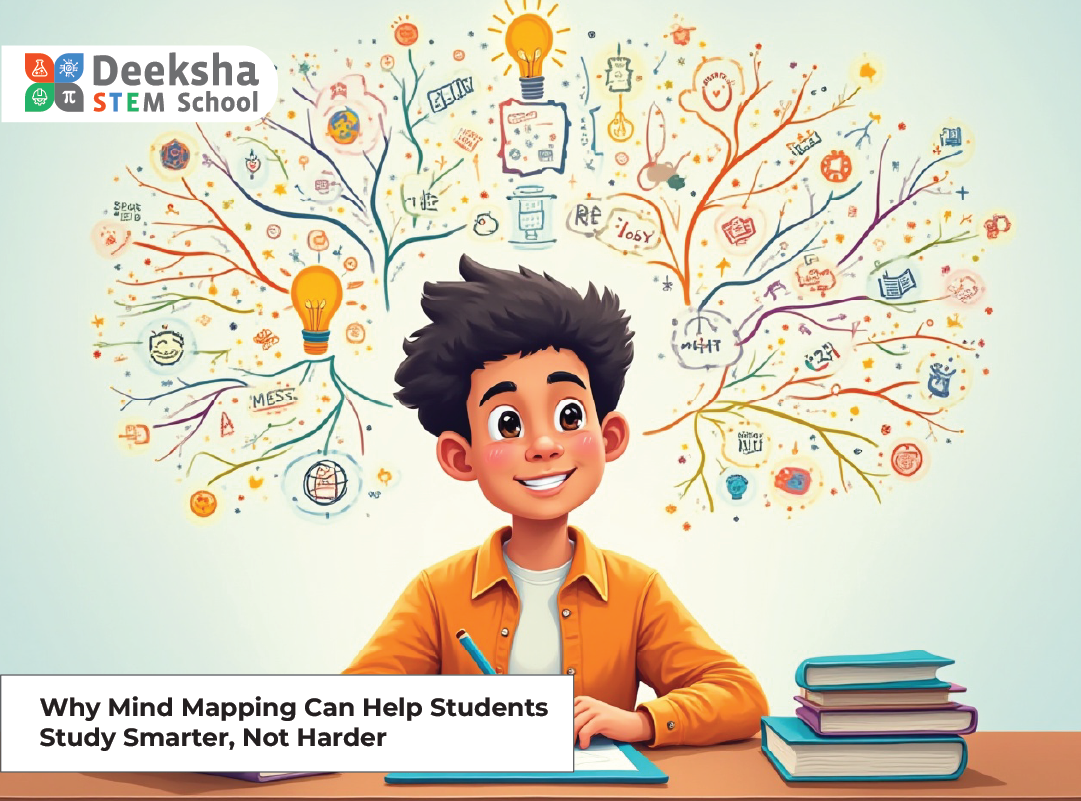Why Mind Mapping Can Help Students Study Smarter, Not Harder

In today’s fast-paced academic environment, students are under constant pressure to absorb, retain, and apply vast amounts of information. Traditional study methods often rely on rote memorization, which can lead to burnout, confusion, and surface-level learning. That’s where mind mapping comes in—a powerful visual learning technique that allows students to truly understand and engage with the material they study.
Mind mapping is more than just a fancy way of taking notes. It changes the way students process, retain, and apply information. At Deeksha STEM Schools, we’ve seen firsthand how this tool empowers learners by making studying a more interactive, creative, and brain-friendly experience. Through mind maps, students not only study smarter but also enjoy the learning process much more.
What is Mind Mapping?
Mind mapping is a diagram-based method used to organize and present information in a visual format. It starts with a central topic placed at the center of a page, and from there, branches radiate outward to represent related ideas, subtopics, and specific details. The technique encourages visual, non-linear thinking, and leverages colors, symbols, and keywords to boost memory and understanding.
Key Features:
- Visual structure: Helps learners spot connections between concepts and establish hierarchies
- Non-linear thinking: Encourages students to approach problems from multiple angles
- Multi-sensory approach: Utilizes visual, spatial, and verbal elements to engage the brain more holistically
- Creative expression: Allows room for personalization through images, illustrations, and color schemes
Benefits of Mind Mapping for Students
Mind mapping has become a go-to study tool at Deeksha STEM because it offers a variety of cognitive, emotional, and academic benefits.
| Benefit | How It Helps |
| Boosts memory retention | Visual pathways and associations make it easier to recall information |
| Enhances understanding | Encourages students to look at the bigger picture and relationships between ideas |
| Improves focus | Provides a clear layout, minimizing distractions and decision fatigue |
| Saves revision time | Offers a concise summary of entire chapters or subjects at a glance |
| Stimulates creativity | Engages both the left (logical) and right (creative) brain hemispheres |
| Increases motivation | Makes studying feel more enjoyable and engaging |
| Improves organization | Helps students structure their thoughts clearly |
When to Use Mind Mapping
Students can incorporate mind maps into a variety of academic tasks. Some of the best use cases include:
- Exam preparation: Create a mind map per subject or chapter to consolidate important points
- Note-taking in class: Capture lecture highlights quickly and logically
- Essay and writing planning: Lay out thesis statements, supporting arguments, and evidence
- Project brainstorming: Visualize and connect components for group or solo projects
- Creative writing: Plot stories or generate ideas for narratives
- Problem solving in math: Map out strategies and known variables
How Deeksha STEM Integrates Mind Mapping
At Deeksha STEM, we don’t just recommend mind mapping—we weave it into our learning ecosystem:
- Mind Mapping Workshops: Students attend practical workshops to learn and experiment with mapping techniques
- Curriculum Integration: Subjects like biology, history, and literature frequently include mapping-based activities
- Homework and Assignments: Teachers often ask students to submit mind maps summarizing topics
- Peer Collaboration: Group assignments include collaborative mapping to boost communication and idea-sharing
- Technology Integration: Students use digital tools like XMind, MindMeister, and Canva to create maps
- Assessment Support: Mind maps are used as part of revision guides and open-book test preparation
Tips for Creating Effective Mind Maps
To get the most out of mind mapping, students should follow these tips:
- Start with a clear central theme: Write or draw the main idea in the center
- Branch out with clarity: Use thick branches for main topics, thinner ones for subtopics
- Stick to keywords: Use concise words to trigger deeper understanding and recall
- Color-code for structure: Assign different colors for different themes or subjects
- Add visuals: Use images, symbols, or doodles to reinforce meaning
- Review and refine: Redraw or clean up your map after understanding improves
- Keep it spacious: Avoid overcrowding; allow your brain to breathe visually
Frequently Asked Questions
1. Is mind mapping suitable for all subjects?
- Absolutely. Whether it’s visualizing a science process, breaking down a historical timeline, analyzing literature themes, or organizing business studies concepts, mind mapping works across disciplines. Even mathematical problem-solving benefits from mapping formulas and steps.
2. Does mind mapping help in exam revision?
- Yes. Mind maps are excellent for revision because they compress vast content into visually digestible formats. Instead of flipping through multiple pages of notes, students can review a single page of well-organized information before an exam.
3. Can students create mind maps digitally?
- Definitely. With the rise of digital tools, students can make vibrant, interactive, and editable mind maps using platforms like MindMeister, XMind, Canva, and even Microsoft OneNote. This also allows easy sharing and collaboration.
4. How is mind mapping different from outlining?
- Outlining is linear, hierarchical, and typically follows a numbered list format. While effective for some learners, it doesn’t engage visual memory as effectively. Mind mapping, on the other hand, is free-flowing, visual, and mimics the way the brain naturally processes information.
5. How does Deeksha STEM support mind mapping?
- We actively encourage mind mapping by integrating it into lesson plans, assessments, and even exam preparation sessions. Faculty provide templates and guidance, and students are recognized and rewarded for creative, well-structured mind maps that demonstrate deep understanding.
Final Thoughts
Mind mapping isn’t just a study aid—it’s a transformative learning strategy. It helps students visualize information, identify relationships, and express ideas creatively. More importantly, it makes learning personal, engaging, and long-lasting.
At Deeksha STEM Schools, we’re committed to helping students go beyond rote learning. We promote techniques that align with how the brain learns best—and mind mapping is one of the most powerful among them. Whether it’s science, language, or exam prep, mind maps empower students to study smarter, not harder.
Explore how our campuses at Bannerghatta Road, Judicial Layout, Kengeri, and Vidyanagar embed visual learning techniques into everyday classroom experiences. Witness how something as simple as a diagram can redefine how your child learns and thrives.




